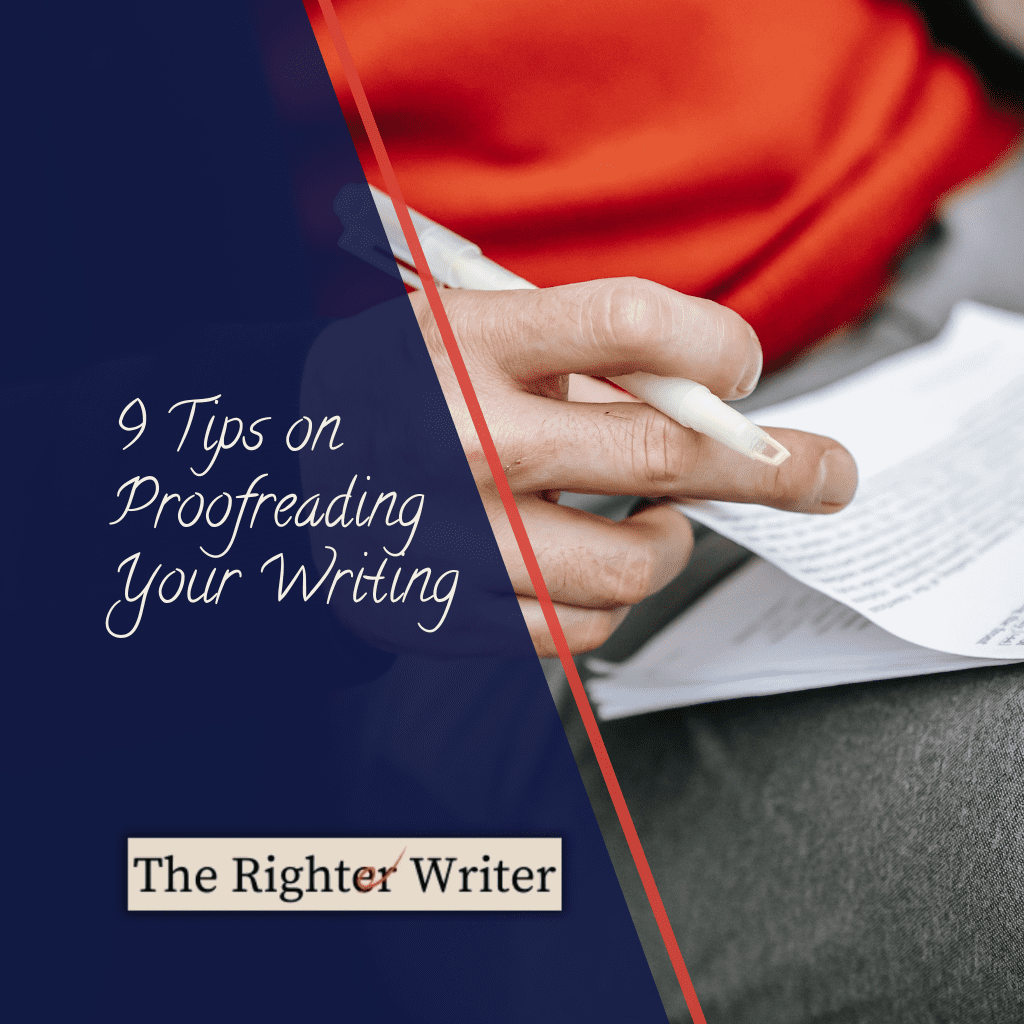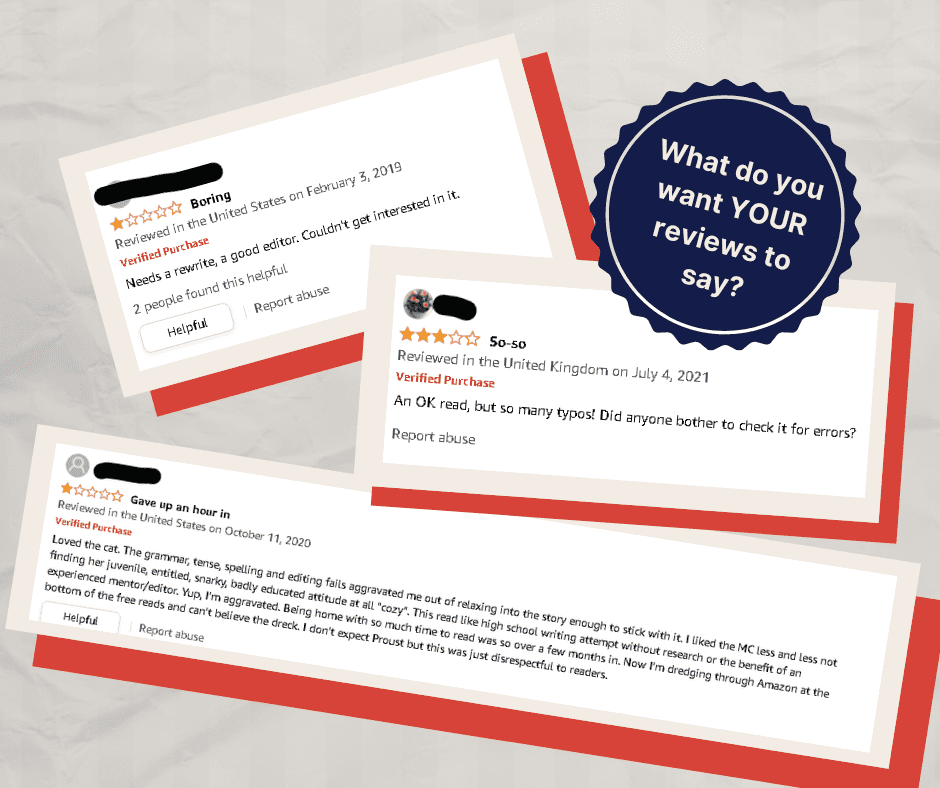
Writing Craft Book Reviews: A Book A Week
Fourth and last (for now!) in our series of book reviews featuring Kindle Unlimited books that explain ways to outline a novel. Let’s get ready for NaNoWriMo!
I'm an affiliate.
Some of the links on this page are affiliate links, but the opinions in my posts are my own, and I only mention products that I like and use myself. As an Amazon Associate, I earn from qualifying purchases. What that means is that if you click one of the links on my site and make a purchase, I might recieve compensation at no extra cost to you.

Can you proofread your own work?
Yes!
Is it easy?
No!
Will these nine tips on proofreading your writing help?
Yes! (Well, I hope so.)
You already know that proofreading your writing is important.
You understand that customers are less likely to trust a website with errors.
And you know that if you do publish something with a mistake in it, the internet will never let you forget it.
You’ve seen the reviews of books that could have used a proofreader before they were published on Amazon.

You already know all that.
What you really need are actionable tips on proofreading your own work quickly and efficiently.
Well, here are nine.
After you’re finished writing and editing, when you think you’re ready to publish, stop and take a step back.
To effectively proofread your own work, you want to see what you actually wrote, not what you thought you wrote.
But when you’ve just finished working on a project, it’s too fresh in your mind; your brain is so full of what you’re trying to say that you may see it there, whether it’s actually on the page or not.
Whether it’s a blog, school paper, novel, or business report, the first thing you should do is close your computer and wait. Give yourself a break so you can come back to it with fresh eyes.
The longer your piece of writing is, the longer you should wait. For a blog post, take a few hours or even overnight. For a complete novel, take a week or two to decompress.
Proofreading should be the very last thing that happens in the writing process.
If you proofread an early draft, you work incredibly hard to take out every typo and put in every (appropriate) piece of punctuation. Then, after you have revised and edited, you will have to do all the work of proofreading over again!
Otherwise, you might find you’ve introduced new errors while you were trying to improve your writing.
Always proofread just before you’re ready to submit.
How long have you spent staring at your document while you write?
Soooo long, right?
No wonder the words start to all look alike!
One way of refocusing yourself during proofreading your writing is to change how the document looks.
Just by changing the font on your document, things that you have read over and over may stand out when you’ve never noticed them before. Slips like, “Oh, I wrote principle, when I meant principal.”
Making your font larger helps, too, for things like, “Oops, that is a comma there, not a period.”
Along with changing the type or size of the font, changing the medium can help you get a new perspective on your work, too.
Changing from a desktop computer to a tablet can help, but one of the best ways is to print out what you’re working on.
That’s pretty easy if it’s a two-page blog post or a two-paragraph email, but it’s a lot harder if it’s a three-hundred-page novel. (It’s probably more important if it’s the novel, though.)
Print it out double spaced, so you have room for notes and can read them afterward, and then grab yourself a pen and read through it slowly and carefully, making notes as you go.
We’re over halfway through our list of tips to proofreading effectively.
Are you starting to flag a bit?
I get that—it takes energy to focus on one thing for a long time.
If your piece is really long, you can’t expect to proofread it all in one sitting.
Take a break partway through to get a coffee, go for a walk, or run some errands. Then you can come back to it.
I know that, if I edit for more than an hour at a stretch, the words start to swirl together, and I miss things. Even if I take breaks, I know I can only edit or proofread for three or four hours each day if I want to be at my best.

Proofreading is looking for mistakes in the words on the page, not in the bigger picture.
Sometimes, though, the words get lost in the story, especially when you’re proofreading your own work. Because you know it so well, it can be really difficult to separate the words from your ideas.
It’s easier to focus on the minutia if you can come at your work from a different direction, either metaphorically or literally. If you’re missing little things when you proofread, you might try a (literal) different direction, by starting at the end of the document.
Read the last sentence, then read the next-to-the-last sentence, then the one before that. You can trick your brain into seeing each word or sentence as an individual item to proofread, rather than as part of a longer narrative.
This is a good way to find dangling modifiers, run-on sentences, or sentence fragments that could get lost when you’re reading complete paragraphs.
This tip for proofreading works well for editing, too.
When we’re reading something out loud, we follow the punctuation marks.
We take a short pause where there’s a comma, and we take a longer pause when there’s a semicolon; a period gets the longest pause of all.
Reading a document out loud is an effective way to see if your punctuation is off. Having someone else read it out loud can help even more.
Listen to where they stumble or have problems putting the ideas together. Listen to where they have to break up a sentence to breathe; that means it’s probably a run-on. On the other hand, it’s an excellent sign if someone can read your text smoothly and clearly the first time that they see it.
If you have a product name, an acronym, a character name, or a person’s name that has an interesting spelling and autocorrect often flags it, it’s worth it to make an extra proofreading pass just to check for those words that you know could use a second look.
For instance, if I write the name of my blog (TheRighterWriter), spell check is going to flag it every time, and, every time, it’s going to have that wavy line underneath it. I get so used to seeing that particular word highlighted by autocorrect that I would never notice if I spelled it “TheWriterRighter” at one point. Both of them would show as wrong, just the same.
This goes for numbers too! The numerals 145 look a lot like 154 when you’re just skimming over your writing. If you have a lot of numbers in your work—in a financial report, for instance—take extra time to go over your figures.
This also applies if you are working with financial or scientific documents that have graphs or charts. For those documents, keep in mind the next of these tips to proofreading effectively.
Can you proofread your own work effectively?
Of course you can, but should you?
If you’re writing something very long, like a novel, or very important, like a graduate thesis, I recommend getting another person to look it over before you submit it.
A professional proofreader is one choice (and you can always contact me here), but it’s not your only choice. If you know a retired teacher, someone in your field who has extra time, or even just a friend who reads a lot, it would be worth it to ask them to proofread your final draft.
It still takes time and effort, though, to make sure that you spot even the tiniest mistake in your document, but it’s worth it. Hopefully, these tips to proofreading your own writing will help make the process a little less painful.
If you want more practice proofreading your own writing, check out my other posts on using the CUPS strategy for editing:
and spelling.
If you have your own proofreading tips or if you have a proofreading question, leave a comment.
I’d love to hear from you!

I help authors, researchers, business people, students, and web marketers to polish their writing before they send it out into the world.

Fourth and last (for now!) in our series of book reviews featuring Kindle Unlimited books that explain ways to outline a novel. Let’s get ready for NaNoWriMo!

Third in our series of book reviews featuring Kindle Unlimited books that explain ways to outline a novel. Let’s get ready for NaNoWriMo!

Second in our series of book reviews featuring Kindle Unlimited books that explain ways to outline a novel. Let’s get ready for NaNoWriMo!

2 Responses
Great tips. After I read it a thousand times, I ask my husband and parents to read it with a fresh pair of eyes.
Having friends and family around sure helps, doesn’t it? <3